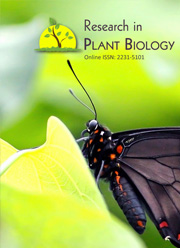Morphological and Histological Observation of Embryogenic Calli Derived from Immature Embryo of BRRI Dhan28 (Oryza sativa L.) Variety
Keywords:
Rice, callus, embryogenesis, morphology, histologyAbstract
Somatic embryogenesis is the most common method for regeneration in rice. In vitrostudies of indica rice (Oryza sativa L.) variety BRRI dhan28 was used for obtainingembryogenic calli from immature embryo culture on Murashige & Skoog mediumsupplemented with 2.5 mg/l dichlorophenoxyacetic acid (2,4-D) and 0.5 mg/lnaphthaleneacetic acid (NAA) showed the highest percentage (91%) of callus induction. Inthis combination 80% embryogenic calli were formed uneven with a crisp texture, loosestructure and salient multicellular structures on the surface while non embryogenic calliwere compact with a smooth surface. Under microscopic observation, embryogenic cells weresmaller, globular and abundant in cytoplasm with one or two big nuclei. Non embryogeniccells were little cytoplasm and few large vacuoles with no or only a small nucleus and wideintercellular spaces. Non embryogenic cells had a very low cell division capability whileembryogenic cells had a high capability for cell division and continued to divide andproduced somatic pro-embryos with a well–defined protodermis which could developfurther through the typical globular, heart, torpedo and cotyledonary stages. Only 80% ofembryogenic cells were induced high differentiation rate and developed 65 globular, 52heart-shape, 43 torpedo and 37 cotyledonary embryos of embryogenic cells after 30 to 45 daysof induction.Downloads
Download data is not yet available.
Published
21-10-2013
How to Cite
Islam, M. M., Haque, M. E., Alam, S. M. M., Islam, M. A., Khalekuzzaman, M., & Sikdar, B. (2013). Morphological and Histological Observation of Embryogenic Calli Derived from Immature Embryo of BRRI Dhan28 (Oryza sativa L.) Variety. Research in Plant Biology, 3(5). Retrieved from https://updatepublishing.com/journal/index.php/ripb/article/view/2497
Issue
Section
Articles



 .
. 